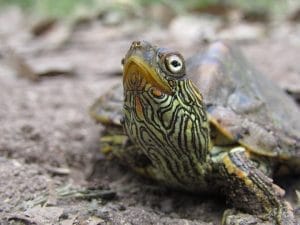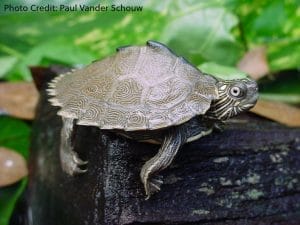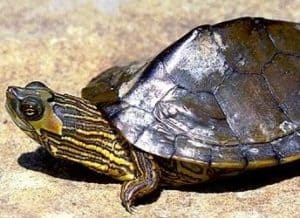Graptemys geographica (Common Map Turtle)
Home > Turtle Database > Graptemys geographica (Common Map Turtle)

Graptemys geographica, commonly known as the Common Map Turtle, is a freshwater turtle species native to North America. Renowned for the intricate, map-like patterns on its shell, this turtle is a captivating inhabitant of rivers and streams across the eastern United States and southeastern Canada.
Native To These Regions
Alabama (USA), Arkansas (USA), Georgia (USA), Illinois (USA), Indiana (USA), Iowa (USA), Kansas (USA), Kentucky (USA), Louisiana (USA), Manitoba (Canada), Michigan (USA), Minnesota (USA), Mississippi (USA), Missouri (USA), Nebraska (USA), New York (USA), Ohio (USA), Oklahoma (USA), Ontario (Canada), Pennsylvania (USA), Quebec (Canada), South Dakota (USA), Tennessee (USA), Texas (USA), Virginia (USA), West Virginia (USA), Wisconsin (USA)Native Turtle Species Map – Find Turtles by Region
Scientific Classification
- Kingdom: Animalia
- Phylum: Chordata
- Class: Reptilia
- Order: Testudines
- Family: Emydidae
- Genus: Graptemys
- Species: G. geographica
Common Names
- Common Map Turtle
- Northern Map Turtle
This Hilarious Turtle Book Might Know Your Pet Better Than You Do
Let’s be real—most turtle care guides feel like reading a textbook written by a sleep-deprived zookeeper.
This one’s not that.
Told from the snarky point of view of a grumpy, judgmental turtle, 21 Turtle Truths You’ll Never Read in a Care Guide is packed with sarcasm, sass, and surprisingly useful insights.
And hey—you don’t have to commit to the whole thing just yet.
Grab 2 free truths from the ebook and get a taste of what your turtle really thinks about your setup, your food choices, and that weird plastic palm tree.
It’s funny, it’s honest, and if you’ve ever owned a turtle who glares at you like you’re the problem—you’ll feel seen.
Identification
Description
The Common Map Turtle features an olive to dark brown carapace adorned with fine yellow lines resembling the contours of a map. The shell is smooth with a slightly serrated rear edge. The plastron (underside) is lighter, usually yellowish, and may have dark markings. Their skin is dark with yellow stripes along the neck, limbs, and head, and a small yellow spot located behind each eye.
Sexual Dimorphism
Females are significantly larger than males, with carapace lengths reaching up to 27 cm (about 10.5 inches), while males typically grow up to 16 cm (about 6 inches). Females have broader heads and stronger jaws, adapted for crushing mollusk shells, whereas males have longer tails and more elongated claws on their front limbs.
Check more turtles from the Graptemys genus
Native Origin and Distribution
Geographical Range
The Common Map Turtle is native to North America, predominantly found in the Great Lakes region, Mississippi River system, and other rivers and streams from southern Quebec and Ontario down to northern Georgia and westward to eastern Oklahoma and Kansas.
Preferred Habitat
They inhabit large bodies of water such as rivers, lakes, and streams with moderate to strong currents. Preferred habitats include areas with abundant basking sites like logs and rocks, soft bottoms, and plentiful aquatic vegetation for foraging.
Behavior
Feeding Habits
Common Map Turtles are primarily omnivorous. Females tend to be molluscivorous, feeding on clams, snails, and other hard-shelled organisms due to their stronger jaws. Males and juveniles consume a variety of insects, crustaceans, and occasionally aquatic vegetation.
Predators
Predators of the Common Map Turtle include raccoons, skunks, foxes, and birds of prey. Eggs and hatchlings are especially vulnerable to predation from mammals and birds.
Reproduction
Breeding Season
Breeding occurs in spring and fall, with nesting typically taking place from May to July. Females come ashore to lay eggs in sandy or soft soil near water sources.
Reproductive Method
Females lay clutches of 6 to 20 eggs, which incubate for approximately 70 to 80 days. The sex of the hatchlings is temperature-dependent, a phenomenon known as temperature-dependent sex determination.
Conservation
Extinction Status
The Common Map Turtle is listed as “Least Concern” on the IUCN Red List, indicating it is not currently at significant risk of extinction.
Threats
Threats to their population include habitat destruction due to development and pollution, disturbance from human recreational activities, and incidental capture in fishing gear. Illegal collection for the pet trade also poses a risk.
Conservation Measures
Conservation efforts focus on protecting natural habitats, enforcing regulations against illegal trade, and implementing measures to reduce bycatch in fishing operations. Public education campaigns aim to raise awareness about the species and its ecological importance.
Economic Importance
While not a major contributor to the economy, Common Map Turtles play a role in controlling populations of mollusks and insects, thus contributing to the balance of aquatic ecosystems. They are also of interest in the pet trade and for educational and research purposes.
Interesting Facts
- The intricate patterns on their shells not only give them their name but also serve as excellent camouflage among aquatic vegetation.
- Common Map Turtles are known for their wary nature and will quickly dive into the water when disturbed.
- They can live for several decades in the wild, with some individuals reaching ages of 20 to 30 years.
- The temperature at which their eggs incubate determines the sex of the offspring—warmer temperatures typically produce females, while cooler temperatures produce males.

About Author
Muntaseer Rahman started keeping pet turtles back in 2013. He also owns the largest Turtle & Tortoise Facebook community in Bangladesh. These days he is mostly active on Facebook.














